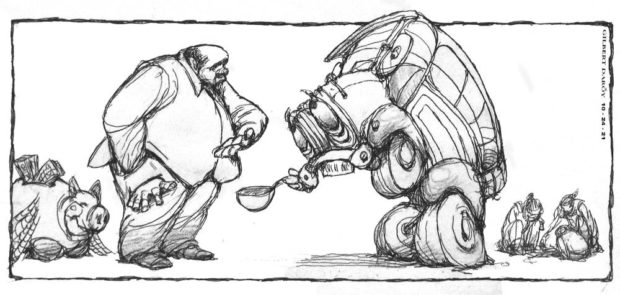Distressed sector

Along with the health care sector, count the drivers, conductors, and other members of the transport sector among those that have been hit hardest by the pandemic lockdowns. Their distress appears to be never-ending: Last year, at the height of the strictest lockdown that severely limited public mobility, drivers of public utility vehicles (PUVs) were forced to take to the empty streets and resort to begging after they lost their livelihood. This week, bus workers under the government’s free-ride program complained about unpaid wages, while the remaining jeepney drivers faced rejection over their plea for a fare hike in the face of spiraling fuel prices.
Even as the economy is slowly opening up and more commuters are returning to work, transport workers have to deal with a new challenge — the continuous rise in the prices of petroleum products. Transport groups recently filed a petition seeking a P3 increase in jeepney fare, or to P12 from P9, reasoning that the current minimum fare is not even enough to cover their operating costs since the onset of the pandemic. But Transportation Secretary Arthur Tugade rejected this appeal, saying it is “not the right time” because commuters also have to deal with the high prices of goods. The last time the Land Transportation Franchising and Regulatory Board (LTFRB) approved a fare increase was in 2018.
Tugade gave the assurance that the government is eyeing financial aid for the sector, such as fuel subsidies or discounts for PUVs at gas stations nationwide. He also called on PUV drivers and operators to join the “Libreng Sakay” program, which offers free rides and pays PUV operators and drivers a one-time payout of P4,000, and weekly payments on a per-kilometer basis whether they have passengers or not.
But even this program has been problematic. Drivers and conductors have complained of unpaid salaries even if the two busway consortiums that were part of the service contracting program have already been paid, according to the government. LTFRB chair Martin Delgra said this was already a matter between the bus operators and the drivers and conductors they hired. Many of the workers did not have a Landbank account which probably caused the delay in the payment release, said transportation assistant secretary Mark Steven Pastor.
The LTFRB is also pressuring the two consortiums they contracted for the program to deploy more buses along Edsa. It has issued a show-cause order to the consortiums after it emerged that the companies had averaged only about 120 units out of the agreed cap of 550 buses. This has resulted in a shortage of buses servicing commuters, causing the prolonged queues at Edsa carousel stations that have been documented by many irate netizens. Some passengers have had to wait for at least an hour to get on a bus, as most of the buses passing by are already filled with passengers from the first station in Monumento, Caloocan. Photos of the long lines of passengers filling the connected overpasses in the Edsa-Muñoz intersection went viral last Monday, Oct. 18, the first weekday since Metro Manila relaxed its alert level status and allowed intrazonal and interzonal travel. Physical distancing in the queues could hardly be maintained, and face masks and shields were the only reminder that there is still an ongoing pandemic.
Shockingly, while Tugade has been trying to recruit more buses to sign up for the Libreng Sakay arrangement, the program is likely to be discontinued, because it’s not included in the Department of Transportation’s (DOTr) proposed P150.76-billion budget next year. The DOTr said it had requested P10 billion to extend the program but this was rejected by the Department of Budget and Management due to, according to Albay Rep. Joey Salceda, the department’s “disappointing performance” in the timely release of the budget. How slow has the DOTr been in utilizing the funds, even as many transport workers and their families have been reduced to penury? About P3.3 billion of the P5.56 billion allotted to the LTFRB for this program had yet to be released as of August.
“The absence of any appropriation for active transport and service contracting in the budget of the Department of Transportation is dismaying, especially given that COVID-19 is unlikely to be completely over by next year,” said Salceda. He warned that the government cannot neglect the sector since the recovery of other key industries like manufacturing depends on an adequate transport budget to support a functioning public transport system.
Tugade has urged lawmakers to restore the budget cut, since “this will not only benefit passengers, drivers and conductors, but the entire economy.”
He might as well address his appeal to the President. While the government has cut the budget for a program that benefits the commuting public, Mr. Duterte was heard again last week promising administration candidates that he would give them “sacks of money” to ensure their victory in the 2022 elections.
For more news about the novel coronavirus click here.
What you need to know about Coronavirus.
For more information on COVID-19, call the DOH Hotline: (02) 86517800 local 1149/1150.
The Inquirer Foundation supports our healthcare frontliners and is still accepting cash donations to be deposited at Banco de Oro (BDO) current account #007960018860 or donate through PayMaya using this link.




















